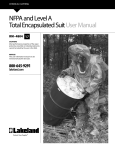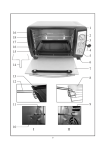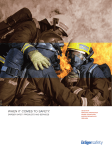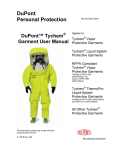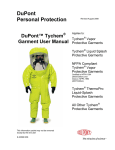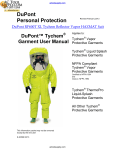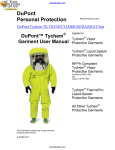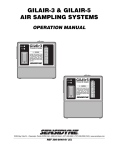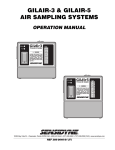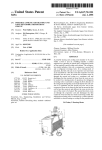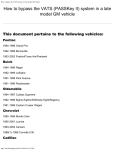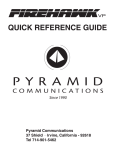Download Technical Data Package DuPont™ Tychem
Transcript
Technical Data Package DuPont™ Tychem® BR & Tychem® LV BR611T & LV611T Compliant with Class 2 of NFPA 1994, 2007 Edition Consult the DuPont™ Tychem® User Manual for Instructions on Use Revised March 2008 This information packet may not be removed except by the end user K-17399 Rev 3/08 Technical Data Package – DuPont™ Tychem® BR611T & LV611T Technical Data Package DuPont™ Tychem® BR611T & LV611T Ensembles Compliant with Class 2 of NFPA 1994, 2007 Edition Consult the Tychem® User Manual for Instructions on Use • the flexible respirator seal on this garment • the gloves • the boots • the garment label NOTE: Tychem® BR611T and Tychem® LV611T garments are not a replacement for Level A garments. They do not provide the same high level of liquid-splash and chemical-vapor protection obtained with Level A garments. If you are donning this garment outdoors, use a ground cloth to avoid damaging your garment. Use a stable chair, bench or stool which is free of sharp edges. Donning 1. Remove all jewelry and personal items (pens, key rings, badges, pagers, radios, knife cases, etc.) that might damage the garment. Donning and Doffing the BR611T and LV611T Ensembles Have a second person assist you in donning (putting on) or doffing (taking off) the BR611T or LV611T ensembles. You and your assistant must read, understand and follow these instructions. Before you attempt to use this garment you must be familiar with the operation of this ensemble. Read and understand the following: 2. Check function of your respirator and place it within reach. 3. Visually check size and condition of outer boots and place them nearby. 4. Conduct a visual inspection of the garment before you begin donning: • these Donning and Doffing Instructions • this Technical Data Package • the DuPont™ Tychem® User Manual which accompanies this garment • the garment label • the documentation that accompanies your respirator Be familiar with the operation and use of: • • your respirator • Page 2 of 13 garment must be free of discoloration or physical damage garment must not smell. Technical Data Package – DuPont™ Tychem® BR611T & LV611T • • • Do not use a garment that has been damaged, altered or contaminated. inner gloves must be fully inserted into outer gloves flexible facepiece seal must be free of distortion or physical damage 5. Remove your shoes. The garment has socks. These socks are worn inside additional outer chemical boots. These socks do not have adequate durability or slip resistance to be worn as the outer footwear covering. 6, Open garment closure completely. Pull the hook-and-loop tape apart, unzip zipper. 7. Sit in a chair and with the aid of your assistant place your feet into the suit and down into socks. Stretch out your legs to maximum extension while pulling garment up around hips. 9. Put your outer boots on each foot and pull boot flaps down over outer boots 10. Don your respirator facepiece according to the respirator manufacture’s instructions 8. Pull your boot flaps up on each leg. Page 3 of 13 Technical Data Package – DuPont™ Tychem® BR611T & LV611T 11. Stand and place arms into sleeves making sure fingers fit into gloves. - Continue placing the seal around the face moving towards forehead. Make sure the edge of outer flexible facepiece seal is flush with the facepiece, makes a continuous seal around the facepiece and is as close to the lens frame as possible. 12. Pull upper portion of coverall over head. 14. Once outer facepiece seal is in place have your assistant go behind you and reach through the opening of the suit to make sure that the inner elastic opening is placed on the facepiece surround. 15. Pull zipper from bottom to top to close. Hold zipper together to zip close. 13. Tilt your head up to assist in proper placement of outer and inner facepiece seals. Have your assistant position the flexible face seal around the respirator facepiece, starting with the chin, 16. Place inner flap over zipper. 17. Have your assistant complete the fastening of storm flaps while you bend Page 4 of 13 Technical Data Package – DuPont™ Tychem® BR611T & LV611T forward at the waist with back and arms hanging downward. DOFFING Have a second person assist you in doffing (taking off) the BR611T or LV611T ensembles. You and your assistant must read, understand and follow these instructions. If your garment has been contaminated or is suspected of being contaminated, then - you must first undergo field decontamination. 18. Squat down and cross arms to remove excess air from the suit. - continue to use your respirator until the garment has been doffed and removed. - your assistant must wear protective clothing and respiratory equipment. 1. Have your assistant help you remove the SCBA backpack without disconnecting the regulator from the facepiece. The tank must be held by wearer or placed in a dry, secure position. Wearer must always hold facepiece in place during doffing. 19. Don your SCBA harness per manufacturing’s instructions. 20. Have your assistant recheck the flexible facepiece seal. 2. Have your assistant wipe any excess liquid from the surface of your garment before opening the suit. 3. While you stand, have your assistant open the hook-and-loop closure of your garment and pull third storm flap away from zipper. Wipe away liquid from the flaps as they are opened. Page 5 of 13 Technical Data Package – DuPont™ Tychem® BR611T & LV611T 4. Once all the flaps are opened and excess liquid removed, then unzip the zipper from top to bottom. 8. Have your assistant continue to peel the garment away from your shoulders and torso by turning the garment partially inside out. 9. Have your assistant hold the wrists of you garments while you remove your hands from the gloves. 5. Have your assistant pull the unzipped opening around wearers shoulder toward wearer’s sides. 6. Tilt your head down and place at least one hand in the center of your facepiece to hold it in place while removing the hood of the garment. Have your assistant stand in front of you in order to peel the hood over your head from back to front, turning it partially inside out. 7. Have your assistant use one hand to help you retain the seal of your respirator to your face while pulling the hood of the garment away from your facepiece. 10. After your assistant has lowered the garment below your waist sit down. 11. Have your assistant remove the outer boots. If these boots are contaminated, they move them a safe distance away from you. Page 6 of 13 Technical Data Package – DuPont™ Tychem® BR611T & LV611T 12. Have the assistant pull the suit off of your legs. - Outer Glove: Guardian #IN 35 Neoprene 13. Have your assistant move the suit and SCBA harness to a safe distance away from you immediately after you disconnect your regulator from your facepiece, 14. Finally, remove your respirator facepiece. These gloves are unlined and have no surface treatments. Gloves are available in five size combinations to fit hands from less than 9 inches to 11 inches in circumference. The gloves are sewn together at the gauntlet. A flexible cone is placed inside the inner glove at the wrist and jam fit into a cone sewn at the end of the garment sleeve. Accessories Accessories and pass through options are listed in an attached document, “DuPont™ ® Tychem Accessories List”. Sizes These NFPA 1994, Class 2 compliant DuPont™ Tychem® BR611T & Tychem® LV611T Ensembles are available in the following sizes: S, M, L, XL, 2XL and 3XL. The non-encapsulating garment sizing chart found in the Tychem® User Manual applies to these garments. Components The chemical barrier garment element of the ® NFPA 1994, Class 2 compliant Tychem ® BR611T & Tychem LV611T ensembles are made from a proprietary multi-layer chemical barrier fabric. The chemical garment seams are sewn with a serge stitch with cotton/polyester thread and sealed with hotair welded chemical barrier tape outside. There is no visor. The diaphragm around the facepiece opening consists of butyl rubber attached to a CPE gasket which in turn, is sealed to the hood of the garment. The glove configuration consists of: Chemical barrier socks and boot top covers are attached to the garment. The attached socks and boot top cover are made from suit material. The socks provide the footwear barrier protection. The ensembles are certified with Onguard HazMax® 87012 boots that are worn over the socks and under the boot top covers. These boots have steel toes and ladder shanks and provide physical protection. There are no surface treatments applied to the boots. These boots are available in sizes 6 to 15. The boots are not physically attached to the garment. The boots are not provided with the ensemble and must be purchased separately The zipper is 38” inches long for garments size SM to 2X and 42” long for sizes 2XL and 3XL. The zipper is vertically mounted and liquid-resistance. The slider components are nylon. The closure is mounted on a polyester tape that is sewn to the chemical barrier garment. The closures are covered by three flaps made of primary garment material. The flaps are fastened with opposing hook-and-loop tapes. There are no exhaust valves or external fittings provided with this garment. The garments were certified with a constructiontype hardhat with front brim. - Inner Glove: Ansell Barrier® Style 2-1 Page 7 of 13 Technical Data Package – DuPont™ Tychem® BR611T & LV611T Compliance with Design Requirements Section 6.1 6.1.1 6.1.2 6.1.3 6.1.4 6.1.5 6.1.6 6.1.7 6.1.8 6.1.8.1 6.1.8.2 6.2 6.2.1 6.2.2 6.2.3 6.2.4 6.2.5 6.2.6 6.3 6.3.1 6.3.2 6.3.3 Chapter 6 - Design Requirement Protective Ensemble Requirements. Ensembles shall have at least the applicable design requirements specified in section 6.1) of this standard when inspected by the certification organization. Ensembles shall be designed to protect the wearer's upper and lower torso, head, hands, and feet. Ensembles elements shall include protective garments, protective gloves, and protective footwear. Ensembles shall be designed to be worn for a single exposure at incidents involving CBRN terrorism agents Ensembles shall be permitted to be designed as either encapsulating or non-encapsulating, and shall be so designated on the product label. Any ensemble certified as Class 2, Class 3, or Class 4 shall be permitted to also be certified to any other or both other class ensembles covered in NFPA 1994. Ensembles shall accommodate the respirators specified by the manufacturer for the specific ensemble. All respirators specified by the ensemble manufacturer for inclusion in Class 2, Class 3, or Class 4 ensembles shall be certified by the National Institute for Occupational Safety and Health (NIOSH) as compliant with the Statement of Standard for NIOSH CBRN SCBA Testing, or with the Statement of Standard for NIOSH CBRN APR Testing, or with the Statement of Standard for NIOSH CBRN PAPR Testing. All respirators shall cover the eyes, nose, and mouth at a minimum. All respirators specified in 6.1.8 for inclusion in Class 2 ensembles shall be CBRN self-contained breathing apparatus. (SCBA) Where the respirator specified in 6.1.8 is an open circuit SCBA, the SCBA shall also be certified as compliant with NFPA 1981, Standard on Open-Circuit Self-Contained Breathing Apparatus for Fire and Emergency Services. Compliant Compliant Compliant Compliant Non-encapsulating Not Applicable Compliant Compliant Compliant Compliant Garment Element Requirements. Garments shall have at least the applicable design requirements specified in this section when inspected by the certification organization. Garments shall be designed and configured to protect at least the wearer's upper and lower torso, arms, and legs and the head with the respirator. Garments shall be designed for a single exposure wearing at incidents involving CBRN terrorism agents. Where garments incorporate booties, the booties shall be designed as an extension of the garment leg and shall cover the entire foot and ankle. Garments shall be offered in at least four unique and different sizes. All garment hardware and external fittings shall be free of rough spots, burrs, or sharp edges that could abrade or tear primary materials. Compliant Compliant Compliant Compliant Compliant Compliant Glove Element Requirements. Gloves shall have at least the applicable design requirements specified in this section where inspected by the certification organization. Gloves shall provide protection from the fingertips to at least 25 mm (1 in.) beyond the wrist crease. Gloves shall be designed to be worn for a single exposure at incidents involving CBRN terrorism agents. Page 8 of 13 Compliant Compliant Compliant Technical Data Package – DuPont™ Tychem® BR611T & LV611T 6.3.4 6.3.5 6.4 6.4.1 6.4.2 6.4.3 6.4.4 6.4.5 6.4.6 6.4.7 In order to label or otherwise represent a glove that meets the requirements of this standard, the manufacturer shall provide gloves in not less than five separate and distinct sizes. All hardware and external fittings shall be free of rough spots, burrs, or sharp edges that could abrade or tear primary materials. Compliant Footwear Element Requirements. Footwear shall have at least the applicable design requirements specified in this section where inspected by the certification organization. Footwear shall provide protection of not less than 200 mm (8 in.) in height when measured from the plane of the sole bottom. Footwear shall be designed for a single exposure wearing at incidents involving CBRN terrorism agents. Protective footwear shall be offered in at least six unique and different sizes. Any metal parts of footwear shall not penetrate from the outside into the lining or insole at any point. No metal parts of footwear, including but not limited to nails or screws, shall be present or utilized in the construction or attachment of the sole with heel to the puncture-resistant device, insole, or upper. All hardware and external fittings shall be free of rough spots, burrs, or sharp edges that could tear primary materials. Compliant Compliant Compliant Compliant Compliant Compliant Compliant Compliance with Performance Requirements Section 7.1 7.1.1 7.1.1.1 Chapter 7 - Performance Requirement Compliance Class 2 Ensembles. Class 2 Ensemble General Requirements. MIST Performance Data with MSA Ultra® Elite Respirator Facepiece and Firehawk® SCBA Harness, Regulator and Tank. Compliant Class 2 ensembles shall be tested for overall inward leakage using the Man-In-Simulant Test (MIST), and shall have an average local physiological protective dosage factor (PPDFi) value at each PAD location for the four ensembles tested of no less than 360.0 and a systemic physiological protective dosage factor (PPDFsys) value for each tested ensemble of no less than 361.0. Systemic PPDFi (ave. of 4) 536 Locals PPDFi Values (average of 4 determinations) Local PPDFi Results Scalp Forehead Behind Left Ear Upper Behind Left Ear Neck Right Neck Left Nape Left Armpit Left inner upper arm Left outer upper arm Left forearm Right forearm Middle back Middle back duplicate Abdomen 1175 1540 25510 1216 1069 25182 1086 4765 11793 9757 26022 23340 28395 28771 27127 Chest Right buttock Lower back Groin Crotch (left0 Crotch (right) Left inner thigh Right inner thigh Left inner shin Right inner shin Right cheek Left cheek Left hand Right hand Foot Page 9 of 13 26715 28910 26347 29918 13808 13694 58250 67671 73493 47544 44972 47202 44417 263966 63302 Technical Data Package – DuPont™ Tychem® BR611T & LV611T 7.1.1.1 MIST Performance Data with Dräger Panorama Nova Respirator Facepiece and AirBoss™ SCBA Harness, Regulator and Tank. Compliant Class 2 ensembles shall be tested for overall inward leakage using the Man-In-Simulant Test (MIST), and shall have an average local physiological protective dosage factor (PPDFi) value at each PAD location for the four ensembles tested of no less than 360.0 and a systemic physiological protective dosage factor (PPDFsys) value for each tested ensemble of no less than 361.0. Systemic PPDFi (ave. of 4) 2410 Locals PPDFi Values (average of 4 determinations) Local PPDFi Results 7.1.1.1 Scalp Forehead Behind Left Ear Upper Behind Left Ear Neck Right Neck Left Nape Left Armpit Left inner upper arm Left outer upper arm Left forearm Right forearm Middle back Middle back duplicate Abdomen 42843 38457 41853 38339 39796 38469 38163 27291 21819 21582 21130 26751 44455 41601 55089 Chest Right buttock Lower back Groin Crotch (left0 Crotch (right) Left inner thigh Right inner thigh Left inner shin Right inner shin Right cheek Left cheek Left hand Right hand Foot 42375 53339 38531 45781 6378 10946 44745 64478 57727 48454 64478 50507 25808 26223 42871 MIST Performance Data with Scott AV-3000 Respirator Facepiece and Corresponding Air-Pak® Harness, Regulator and Tank. Class 2 ensembles shall be tested for overall inward leakage using the Man-In-Simulant Test (MIST), and shall have an average local physiological protective dosage factor (PPDFi) value at each PAD location for the four ensembles tested of no less than 360.0 and a systemic physiological protective dosage factor (PPDFsys) value for each tested ensemble of no less than 361.0. Compliant Systemic PPDFi (ave. of 4) 1505 Locals PPDFi Values (average of 4 determinations) Local PPDFi Results 7.1.1.2 7.1.1.2.1 7.1.1.2.2 Scalp 4631 Chest Forehead 9937 Right buttock Behind Left Ear Upper 10759 Lower back Behind Left Ear 13972 Groin Neck Right 7994 Crotch (left0 Neck Left 13664 Crotch (right) Nape 9378 Left inner thigh Left Armpit 20757 Right inner thigh Left inner upper arm 9434 Left inner shin Left outer upper arm 15593 Right inner shin Left forearm 20744 Right cheek Right forearm 11677 Left cheek Middle back 23590 Left hand Middle back duplicate 24896 52238Right hand Abdomen 52238 Foot Class 2 ensembles shall be tested for overall function and shall allow the test subject to complete all tasks within 20 minutes, and shall allow no liquid penetration in subsequent liquid-tight integrity testing and the garment closure shall remain engaged during the entire garment function testing. Where hoods are provided, garment shall accommodate head protection devices meeting the dimensional requirements of Type I, Class G helmets of ANSI Z89.1, Standard on Industrial Head Protection. Where hoods with visors are provided, garments shall permit the test subject to see with a visual acuity of 20/35 or better Page 10 of 13 7388 15839 14967 20790 5142 8972 36274 16733 25137 24946 28508 28376 8289 15458 25383 Compliant Compliant Compliant Technical Data Package – DuPont™ Tychem® BR611T & LV611T 7.1.1.2.3 7.1.1.3 7.1.1.4 7.1.1.5 7.1.2 7.1.2.1 7.1.2.1(1) 7.1.2.1(2) 7.1.2.1(3) 7.1.2.2 7.1.2.3 7.1.2.4 7.1.2.5 7.1.2.6 7.1.2.7 7.1.2.8 7.1.2.8.1 7.1.2.8.1(1) 7.1.2.8.1(2) 7.1.2.8.1(3) 7.1.2.8.2 7.1.2.8.3 through the combination of the hood visor and the respirator facepiece lens. Where protective flaps cover the closure, the protective flaps shall remain closed for the duration of the overall garment function test. External fittings installed in Class 2 ensembles shall be tested for pull-out strength and shall not have a failure force of less than 1000 N (225 lbf). Exhaust valves installed in Class 2 ensembles shall be tested for mounting strength and shall have a failure force greater than 135 N (30 lbf). Exhaust valves installed in Class 2 ensembles shall be tested for inward leakage and shall not exhibit a leakage rate 3 exceeding 30 ml/min (1.83 in. /min). Compliant Not Applicable Not Applicable Not Applicable Class 2 Garment Element Requirements. Class 2 garment materials and seams shall be tested for permeation resistance and shall meet the following performance criteria: The average cumulative permeation in 1 hour shall not 2 exceed 4.0 ug/cm for chemical warfare agents Distilled Mustard (HD) The average cumulative permeation in 1 hour shall not 2 exceed 1.25 ug/cm for chemical warfare agent Soman (GD). For permeation testing of liquid and gaseous industrial chemicals, the average normalized breakthrough time shall be greater than 60 minutes. Class 2 garment materials shall be tested for bursting strength and shall have a bursting strength of not less than 156 N (35 lbf). Class 2 garment materials shall be tested for puncture propagation tear resistance and shall have a puncture propagation tear resistance of not less than 31 N (7 lbf). Class 2 garment materials shall be tested for cold weather performance and shall have a bending moment of not greater than 0.057 N m ( in.-lbf) at an angular deflection of 60 degrees at -25°C (-13°F). Class 2 garment seams shall be tested for seam strength and shall have a breaking strength of not less than 1.31 kN/m (15 lbf/2 in.). Class 2 garment closure assemblies shall be tested for closure strength and shall have a breaking strength of not less than 1.31 kN/m (15 lbf/2 in.). Class 2 garment materials and seams shall be tested for resistance to liquid or bloodborne pathogens and shall allow no penetration of the Phi-X-174 bacteriophage for at least 1 hour. Compliant Compliant Compliant Compliant Compliant Compliant Compliant Compliant Compliant Compliant Class 2 Garment Visor Requirements. Class 2 garment visor materials and seams shall be tested for permeation resistance and shall meet the following performance criteria: For permeation testing of chemical warfare agent Distilled Mustard (HD), the average cumulative permeation in 1 hour 2 shall not exceed 4.0 μg/cm . For permeation testing of chemical warfare agent Soman (GD), the average cumulative permeation in 1 hour shall not 2 exceed 1.25 μg/cm . For permeation testing of liquid and gaseous industrial chemicals, the average normalized breakthrough time shall be greater than 60 minutes. Class 2 garment visor materials shall be tested for bursting strength and shall have a bursting strength of not less than 156 N (35 lbf). Class 2 garment visor materials shall be tested for puncture propagation tear resistance and shall have a puncture propagation tear resistance of not less than 36 N (8 lbf). Page 11 of 13 Not Applicable Not Applicable Not Applicable Not Applicable Not Applicable Not Applicable Technical Data Package – DuPont™ Tychem® BR611T & LV611T 7.1.2.8.4 7.1.2.8.5 7.1.2.8.6 7.1.3 7.1.3.1 7.1.3.2 7.1.3.2(1) 7.1.3.2(2) 7.1.3.2(3) 7.1.3.3 7.1.3.4 7.1.3.5 7.1.3.6 71.3.7 7.1.4 7.1.4.1 7.1.4.2 7.1.4.2(1) 7.1.4.1(2) 7.1.4.1(3) 7.1.4.3 7.1.4.4 7.1.4.5 Class 2 garment visor materials shall be tested for cold temperature bending at -25°C (-13°F) and shall not crack or show evidence of visible damage. Class 2 garment visor material seams shall be tested for seam strength and shall have a breaking strength of not less than 1.31 kN/m (15 lbf/2 in.). Class 2 garment visor materials shall be tested for resistance to liquid or bloodborne pathogens and shall allow no penetration of the Phi-X-174 bacteriophage for at least 1 hour. Not Applicable Not Applicable Not Applicable Class 2 Glove Element Requirements. Class 2 gloves shall be tested for liquid-tight integrity and shall show no leakage. Class 2 glove materials and seams shall be tested for permeation resistance and shall meet the following performance criteria: The average cumulative permeation in 1 hour shall not 2 exceed 4.0 ug/cm for chemical warfare agents Distilled Mustard (HD) The average cumulative permeation in 1 hour shall not 2 exceed 1.25 ug/cm for chemical warfare agents Soman (GD). For permeation testing of liquid and gaseous industrial chemicals, the average normalized breakthrough time shall be greater than 60 minutes. Class 2 glove materials shall be tested for cut resistance and shall have the distance of blade travel be not less than 25 mm (1 in.) at 200 g load. Class 2 glove materials shall be tested for puncture resistance and shall have a puncture resistance of not less than 15 N (3.8 lbf). Class 2 garment materials shall be tested for cold weather performance and shall have a bending moment of not greater than 0.057 N m ( in.-lbf) at an angular deflection of 60 degrees at -25°C (-13°F). Class 2 gloves shall be tested for hand function and shall have an average percent increase over barehanded control less than 300 percent. Class 2 glove materials and seams shall be tested for resistance to liquid or bloodborne pathogens and shall allow no penetration of the Phi-X-174 bacteriophage for at least 1 hour. Compliant Compliant Compliant Compliant Compliant Compliant Compliant Compliant Compliant Compliant Class 2 Footwear Element Requirements. Class 2 footwear shall be tested for liquid-tight integrity and shall show no leakage. Class 2 footwear upper material and sole shall be tested for permeation resistance and shall meet the following performance criteria: The average cumulative permeation in 1 hour shall not 2 exceed 4.0 ug/cm for chemical warfare agents Distilled Mustard (HD) The average cumulative permeation in 1 hour shall not 2 exceed 1.25 ug/cm for chemical warfare agents Soman (GD), For permeation testing of liquid and gaseous industrial chemicals, the average normalized breakthrough time shall be greater than 60 minutes. Class 2 footwear upper materials shall be tested for cut resistance and shall have the distance of blade travel not be less than 25 mm (1 in.) at a load of 600 g. Class 2 footwear upper materials shall be tested for puncture resistance and shall have a puncture resistance of not less than 36 N (8 lbf). Class 2 footwear soles and heels shall be tested for abrasion resistance and have an abrasion-resistance rating of not less than 65. Page 12 of 13 Compliant Compliant Compliant Compliant Compliant Compliant Compliant Compliant Technical Data Package – DuPont™ Tychem® BR611T & LV611T 7.1.4.6 7.1.4.7 7.1.4.8 7.1.4.9 Class 2 footwear soles shall be tested for slip resistance and shall have a static coefficient of 0.75 or greater. Class 2 footwear upper materials shall be tested for resistance to liquid or bloodborne pathogens and shall allow no penetration of the Phi-X-174 bacteriophage for at least 1 hour. Where the manufacturer specifies the use of a footwear cover to be worn over standard footwear, Class 2 footwear covers shall meet the requirements specified in 7.1.4.1, 7.1.4.2, 7.1.4.3, 7.1.4.4, 7.1.4.6, and 7.1.4.7, excluding 7.1.4.5. Where the manufacturer specifies the use of a footwear cover to be worn over standard footwear, Class 2 footwear covers shall be tested for abrasion resistance and shall show no wear through 3000 cycles. Compliant Compliant Compliant Compliant Product safety information available upon request. This information corresponds to our current knowledge on this subject. It is offered solely to provide possible suggestions for your determination. It is not intended, however, to substitute for any testing you may need to conduct to determine for yourself the suitability of our products for your particular purposes. It is the user’s responsibility to determine the level of risk and the proper protective equipment needed for the user’s particular purpose. This information may be subject to revision as new knowledge and experience becomes available. Since we cannot anticipate all variations in actual end-use conditions, DUPONT MAKE NO WARRANTIES AND ASSUME NO LIABILITY IN CONNECTION WITH ANY USE OF THIS INFORMATION. Nothing in this publication is to be considered as a license to operate under or a recommendation to infringe any trademark or patent rights. Copyright © 2008 E. I. du Pont de Nemours and Company. All rights reserved. The DuPont Oval Logo, DuPont™, The ® miracles of science and all products denoted with ™ or ® are trademarks of E. I. du Pont de Nemours and Company and its affiliates, unless otherwise attributed ® ® HazMax is a registered trademark of Onguard Industries. Barrier is a registered trademark of Ansell Healthcare. ® Firehawk is a registered trademark of Mine Safety Appliances, Inc (MSA) ® Air-Pak is a registered trademark of Scott Health and Safety, Inc. AirBoss™ is trademark of Dräger Safety Corporation (USA) Page 13 of 13















